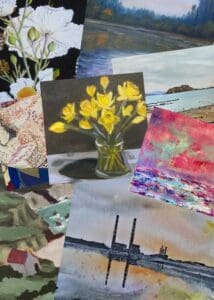When artists talk about the value in a painting they may not be talking about price. It’s just as possible they’re talking about the overall use of dark and light tones on the canvas.
The value of any color is a relative assessment of how light or dark it is. A color with a low value will be very dark, and one with a high value will be light. Putting a very dark color next to a very light color creates high contrast, and putting two colors next to each other with similar values creates low contrast. An extreme example of low contrast would be to paint an entire canvas in one value even if it is painted in many colors.
Perhaps we are viewing a scene of San Francisco and it’s a very foggy day. One of the ways an artist is going to convey that grey city landscape is to develop a composition in which the value of all the colors within the painting are fairly similar. In this painting there might be colors with distinctly differing hues, for example a medium shaded cobalt blue and a deep shaded crimson red, and yet they could have approximately the same value. The challenge for the new student is do discern the value that different colors have.
Value is important to painting because through it’s variations attributes such as depth, texture, volume, distance, source of light, focus points and mood are created.
So its important to become adept at knowing the values of the colors one uses. There are several ways to develop a keener sense of value. The simplest is to squint while looking at subject, or put on a pair of sunglasses. The more we squint, the hazier things become and the richness of all color is drained from our sight. Our view becomes more black and white and the true values, the brightness or darkness of all colors become more apparent. A blue, a dark red and a green can all have the same value.
To truly test your sense of value try this simple and insightful lesson. Take a wooden cube or any cube where all sides are the same color and place in on a piece of cardboard. Then shine a light from an angle so that the cube cast a shadow and has lit and dark faces. Paint three different studies of that cube. In each study, use different colors to paint the various cube faces as well as the shadow that is cast, yet try your best to make each color match the value of the degree of lightness or darkness of the individual sides of the cube.
You now have three paintings of that cube with totally different pallet of colors, but hopefully, three paintings where the variations in value are exactly the same. To see how well you did take each of the paintings and make a black and white copy on a Xerox By producing a black and white copy you reduce all colors to there true values. The three copies should look exactly the same but don’t be disappointed if they don’t! Practice will get you closer.
Source by Phil Gross




